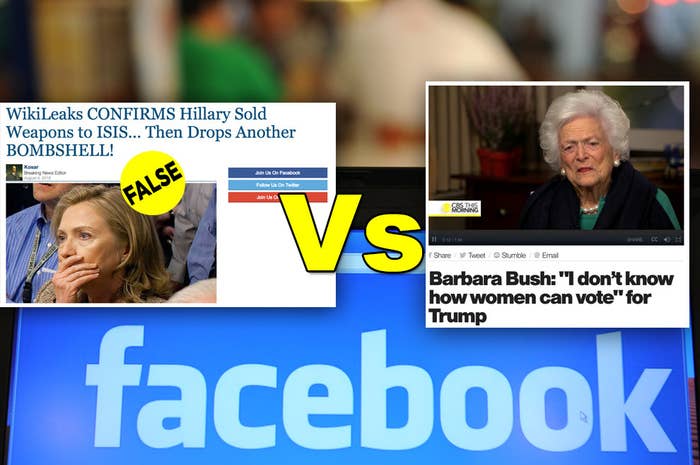
In the final three months of the US presidential campaign, the top-performing fake election news stories on Facebook generated more engagement than the top stories from major news outlets such as the New York Times, Washington Post, Huffington Post, NBC News, and others, a BuzzFeed News analysis has found.
During these critical months of the campaign, 20 top-performing false election stories from hoax sites and hyperpartisan blogs generated 8,711,000 shares, reactions, and comments on Facebook.
Within the same time period, the 20 best-performing election stories from 19 major news websites generated a total of 7,367,000 shares, reactions, and comments on Facebook. (This analysis focused on the top performing link posts for both groups of publishers, and not on total site engagement on Facebook. For details on how we identified and analyzed the content, see the bottom of this post. View our data here.)
Up until those last three months of the campaign, the top election content from major outlets had easily outpaced that of fake election news on Facebook. Then, as the election drew closer, engagement for fake content on Facebook skyrocketed and surpassed that of the content from major news outlets.
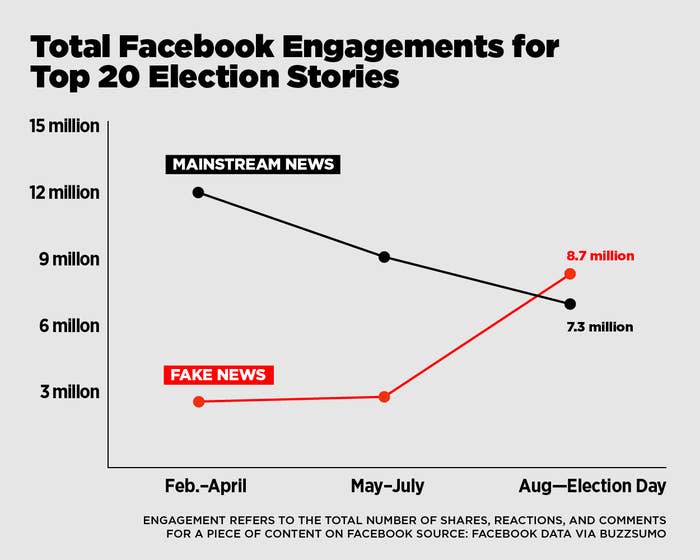
"I’m troubled that Facebook is doing so little to combat fake news," said Brendan Nyhan, a professor of political science at Dartmouth College who researches political misinformation and fact-checking. "Even if they did not swing the election, the evidence is clear that bogus stories have incredible reach on the network. Facebook should be fighting misinformation, not amplifying it."
A Facebook spokesman told BuzzFeed News that the top stories don't reflect overall engagement on the platform.
"There is a long tail of stories on Facebook," the spokesman said. "It may seem like the top stories get a lot of traction, but they represent a tiny fraction of the total."
He also said that native video, live content, and image posts from major news outlets saw significant engagement on Facebook.
Of the 20 top-performing false election stories identified in the analysis, all but three were overtly pro-Donald Trump or anti-Hillary Clinton. Two of the biggest false hits were a story claiming Clinton sold weapons to ISIS and a hoax claiming the pope endorsed Trump, which the site removed after publication of this article. The only viral false stories during the final three months that were arguably against Trump's interests were a false quote from Mike Pence about Michelle Obama, a false report that Ireland was accepting American "refugees" fleeing Trump, and a hoax claiming RuPaul said he was groped by Trump.
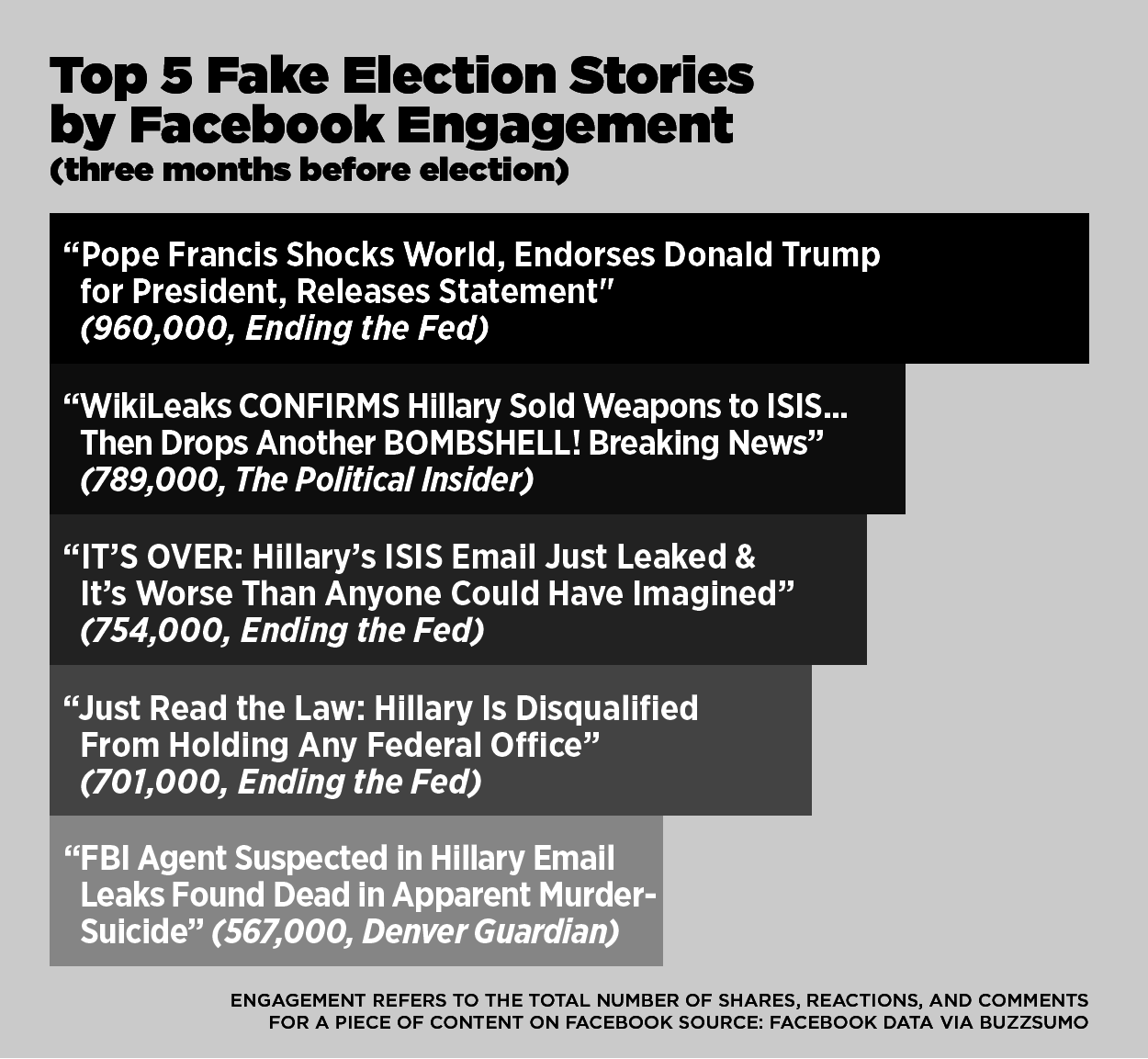
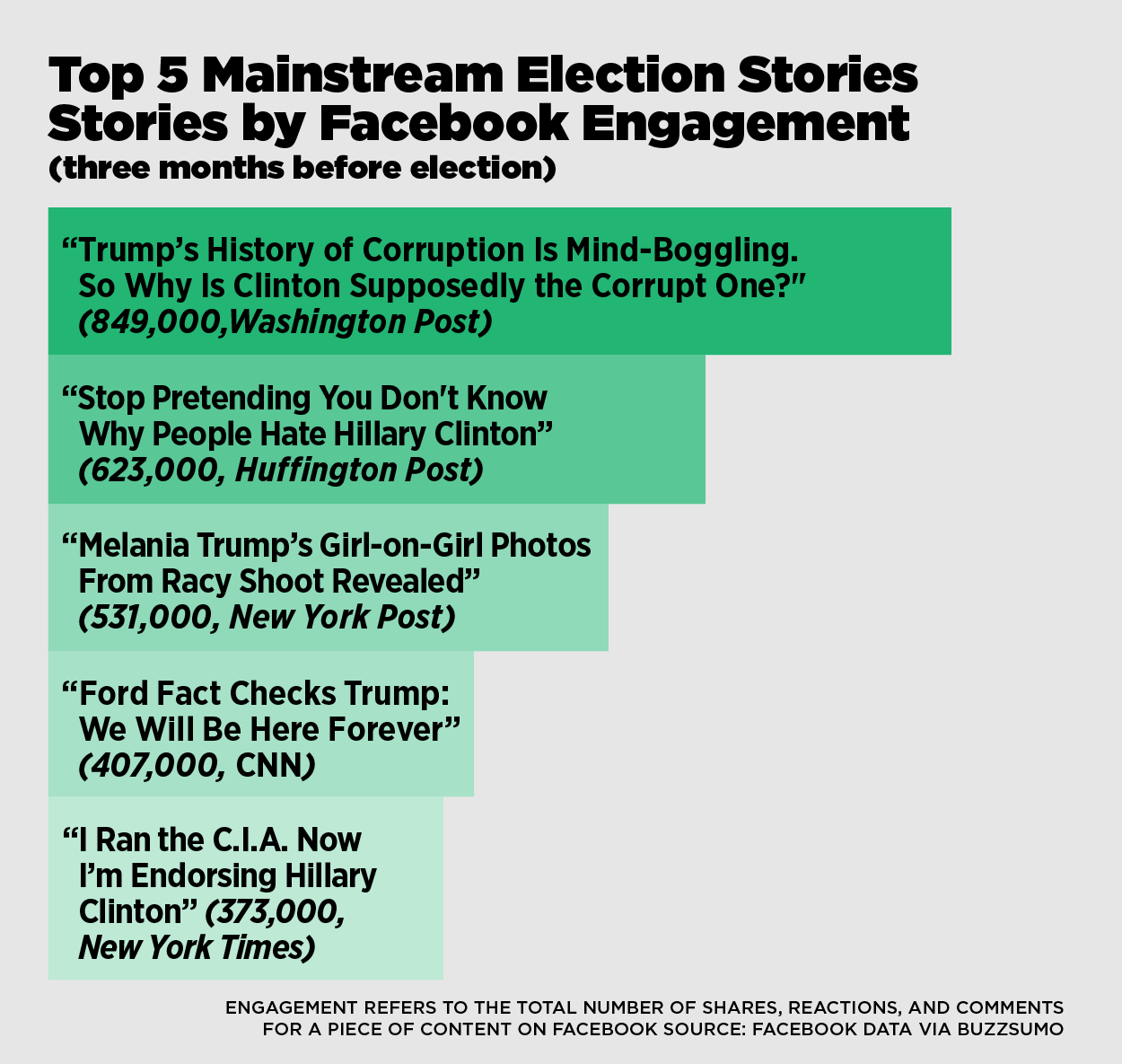
This new data illustrates the power of fake election news on Facebook, and comes as the social network deals with criticism that it allowed false content to run rampant during the 2016 presidential campaign. CEO Mark Zuckerberg said recently it was "a pretty crazy idea" to suggest that fake news on Facebook helped sway the election. He later published a post saying, "We have already launched work enabling our community to flag hoaxes and fake news, and there is more we can do here."
This week BuzzFeed News reported that a group of Facebook employees have formed a task force to tackle the issue, with one saying that "fake news ran wild on our platform during the entire campaign season." The Wall Street Journal also reported that Google would begin barring fake news websites from its AdSense advertising program. Facebook soon followed suit.
These developments follow a study by BuzzFeed News that revealed hyperpartisan Facebook pages and their websites were publishing false or misleading content at an alarming rate — and generating significant Facebook engagement in the process. The same was true for the more than 100 US politics websites BuzzFeed News found being run out of the Former Yugoslav Republic of Macedonia.
This new analysis of election content found two false election stories from a Macedonian sites that made the top-10 list in terms of Facebook engagement int he final three months. Conservative State published a story that falsely quoted Hillary Clinton as saying, “I would like to see people like Donald Trump run for office; they’re honest and can’t be bought.” The story generated over 481,000 engagements on Facebook. A second false story from a Macedonia site falsely claimed that Clinton was about to be indicted. It received 149,000 engagements on Facebook.
All the false news stories identified in BuzzFeed News' analysis came from either fake news websites that only publish hoaxes or from hyperpartisan websites that present themselves as publishing real news. The research turned up only one viral false election story from a hyperpartisan left-wing site. The story from Winning Democrats claimed Ireland was accepting anti-Trump "refugees" from the US. It received over 810,000 Facebook engagements, and was debunked by an Irish publication. (There was also one post from an LGBTQ site that used a false quote from Trump in its headline.)
The other false viral election stories from hyperpartisan sites came from right-wing publishers, according to the analysis.
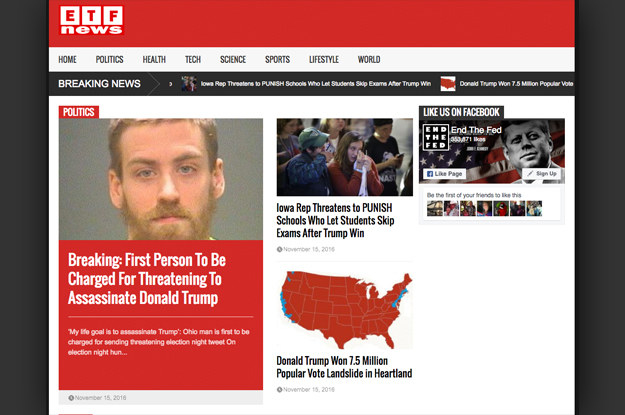
One example is the remarkably successful, utterly untrustworthy site Ending the Fed. It was responsible for four of the top 10 false election stories identified in the analysis: Pope Francis endorsing Donald Trump, Hilary Clinton selling weapons to ISIS, Hillary Clinton being disqualified from holding federal office, and the FBI director receiving millions from the Clinton Foundation. These four stories racked up a total of roughly 2,953,000 Facebook engagements in the three months leading up to Election Day.
Ending the Fed gained notoriety in August when Facebook promoted its story about Megyn Kelly being fired by Fox News as a top trending item. The strong engagement the site has seen on Facebook may help explain how one of its stories was featured in the Trending box.
The site, which does not publicly list an owner or editor, did not respond to a request for comment from BuzzFeed News.
Like several other hyperpartisan right-wing sites that scored big Facebook hits this election season, Ending the Fed is a relatively new website. The domain endingthefed.com was only registered in in March. Yet according to BuzzFeed News' analysis, its top election content received more Facebook engagement than stories from the Washington Post and New York Times. For example, the top four election stories from the Post generated roughly 2,774,000 Facebook engagements — nearly 180,000 fewer than Ending the Fed's top four false posts.
A look at Ending the Fed's traffic ranking chart from Alexa also gives an indication of the massive growth it experienced as the election drew close:
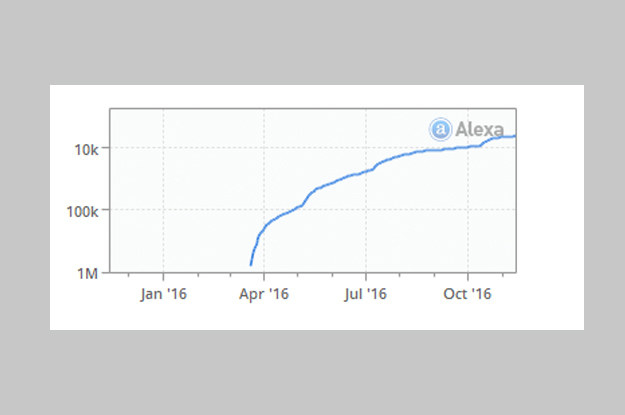
A similar spike occurred for Conservative State, a site that was only registered in September. It saw its traffic rank on Alexa spike almost instantly:

Alexa estimates that nearly 30% of Conservative State's traffic comes from Facebook, with 10% coming from Google.
Along with unreliable hyperpartisan blogs, fake news sites also received a big election traffic bump in line with their Facebook success. The Burrard Street Journal scored nearly 380,000 Facebook engagements for a fake story about Obama saying he will not leave office if Trump is elected. It was published in September, right around the time Alexa notched a noticeable uptick in its traffic ranking:

That site was only registered in April of this year. Its publisher disputes the idea that its content is aimed at misleading readers. "The BS Journal is a satire news publication and makes absolutely no secret of that or any attempt to purposely mislead our readers," he told BuzzFeed News.
Large news sites also generated strong Facebook engagement for links to their election stories. But to truly find the biggest election hits from these 19 major sites, it's necessary to go back to early 2016.
The three biggest election hits for these outlets came back in February, led by a contributor post on the Huffington Post's blog about Donald Trump that received 2,200,000 engagements on Facebook. The top-performing election news story on Facebook for the 19 outlets analyzed was also published that month by CBS News. It generated an impressive 1.7 million shares, engagements, and comments on Facebook. Overall, a significant number of the top-performing posts on Facebook from major outlets were opinion pieces, rather than news stories.
The biggest mainstream hit in the three months prior to the election came from the Washington Post and had 876,000 engagements. Yet somehow Ending the Fed — a site launched just months earlier with no history on Facebook and likely a very small group of people running it — managed to get more engagement for a false story during that same period.
“People know there are concerned employees who are seeing something here which they consider a big problem,” a Facebook manager told BuzzFeed News this week. “And it doesn’t feel like the people making decisions are taking the concerns seriously.”
How We Gathered the Data
BuzzFeed News used the content analysis tool BuzzSumo, which enables users to search for content by keyword, URL, time range, and social share counts. BuzzFeed News searched in BuzzSumo using keywords such as "Hillary Clinton" and "Donald Trump," as well as combinations such as "Trump and election" or "Clinton and emails" to see the top stories about these topics according to Facebook engagement. We also searched for known viral lies such as "Soros and voting machine."
In addition, created lists of the URLs of known fake news websites, of hyperpartisan sites on the right and on the left, and of the more than 100 pro-Trump sites run from Macedonia that were previously identified in BuzzFeed News reporting. We then looked for the top performing content on Facebook across all of these sites to find false stories about the election.
We conducted our searches in three-month segments beginning 9 months from election day. This broke down as February to April, May to July, and August to election day.
Even with the above approaches, it's entirely possible that we missed other big hits from fake news websites and hyperpartisan blogs.
To examine the performance of election content from mainstream sites, we created a list that included the websites of the New York Times, Washington Post, NBC News, USA Today, Politico, CNN, Wall Street Journal, CBS News, ABC News, New York Daily News, New York Post, BuzzFeed, Los Angeles Times, NPR, The Guardian, Vox, Business Insider, Huffington Post, and Fox News. We then searched for their top-performing election content in the same three-month segments as above.
It's important to note that Facebook engagement does not necessarily translate into traffic. This analysis was focused on how the best-performing fake news about the election compared with real news from major outlets on Facebook. It's entirely possible — and likely — that the mainstream sites received more traffic to their top-performing Facebook content than the fake news sites did. As as the Facebook spokesman noted, large news sites overall see more engagement on Facebook than fake news sites.
